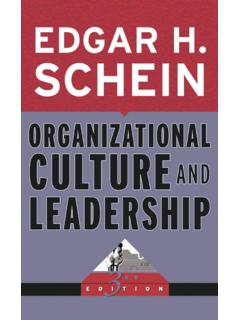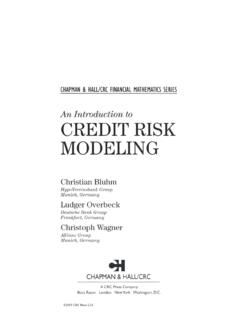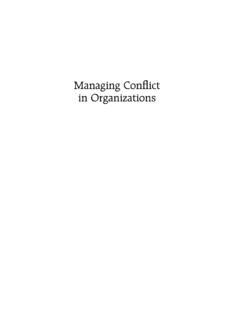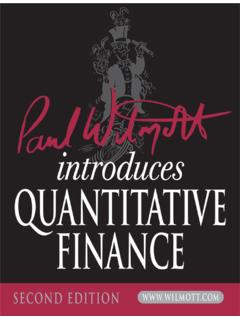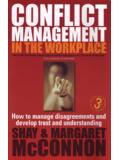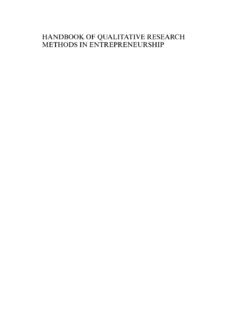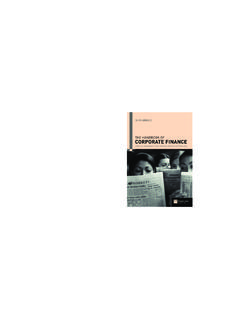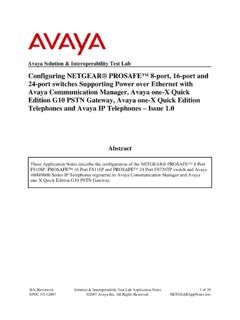Transcription of Changing Organizational Culture: Cultural change ... - …
1 Changing Organizational culture How do people react to significant Organizational change ? Do we see ourselves as helping change to come about, or allowing change to happen around us? How can we adapt more easily to change ? Based around an illuminating extended case-study, this important new text uncovers the reality of Organizational change . From planning and inception to project management and engagement, the book explores the views and reactions of various stakeholders undergoing real life change processes. Drawing on theories of Organizational culture , it helps us to understand how organizations can promote change without alienating the people needed to implement it. Changing Organizational culture represents an original and timely addition to the literature on Organizational change . It is vital reading for all students, researchers and practitioners working in Organizational theory and behaviour, change manage- ment and HRM.
2 Mats Alvesson and Stefan Sveningsson work at the Department of Business Administration, Lund University, Sweden. Changing Organizational culture Cultural change work in progress Mats Alvesson and Stefan Sveningsson First published 2008. by Routledge 2 Park Square, Milton Park, Abingdon, Oxon OX14 4RN. Simultaneously published in the USA and Canada by Routledge 270 Madison Ave, New York, NY 10016. Routledge is an imprint of the Taylor & Francis Group, an informa business This edition published in the Taylor & Francis e-Library, 2007. To purchase your own copy of this or any of Taylor & Francis or Routledge's collection of thousands of eBooks please go to . 2008 Mats Alvesson and Stefan Sveningsson All rights reserved. No part of this book may be reprinted or reproduced or utilized in any form or by any electronic, mechanical, or other means, now known or hereafter invented, including photocopying and recording, or in any information storage or retrieval system, without permission in writing from the publishers.
3 British Library Cataloguing in Publication Data A catalogue record for this book is available from the British Library Library of Congress Cataloging-in-Publication Data A catalog record for this book has been requested ISBN 0-203-93596-9 Master e-book ISBN. ISBN10: 0 415 43761 X (hbk). ISBN10: 0 415 43762 8 (pbk). ISBN10: 0 203 93596 9 (ebk). ISBN13: 978 0 415 43761 5 (hbk). ISBN13: 978 0 415 43762 2 (pbk). ISBN13: 978 0 203 93596 5 (ebk). For Miha and Mathilda, and for Sara and Erik Contents List of figures x List of tables xi Preface xiii PART 1. Perspectives on Organizational and Cultural change 1. 1 Introduction 3. Understanding Organizational change 4. Studying change in depth 7. The purpose of the book 9. The structure of the book 10. 2 Organizational change 13. Forces of Organizational change 14. Views on Organizational change 15. The planning approach 19. The planning approach a critique 26.
4 The process approach 27. Resistance 31. Conclusions 33. 3 Organizational culture and change 35. What is Organizational culture ? 36. Sub-cultures and identity 38. Organizational Cultural change 40. Views of Organizational culture change 44. viii Contents Cultural change : preceding, following from or intertwined with substantive changes'? 47. Conclusions 49. PART 2. change work in practice a close-up study 51. 4 The case and how we studied it 53. The company and its story 53. Investigative model of management and Cultural work 55. Method 57. 5 A Cultural change project I: background, objectives and design 60. Some key actors in our story 61. I Background talk of an existing culture 63. II Objectives: ideas behind and aims for a culture change project 66. III Designing a change project 69. Summary 77. 6 A Cultural change project II: implementation, reception and outcomes 79. IV Implementation and interaction 79.
5 V Reception and interpretation 90. VI Results 92. Summary and questions 96. PART 3. Crucial issues in Cultural change work 97. 7 It is not so damn easy' lack of consistency and expressiveness in Cultural change work 99. Immobilized engagement on the difficulties in getting the process moving 99. Key dimensions behind the problems I: coordination and prioritization 101. Key dimensions behind the problems II: on symbolism, emotionality and expressiveness 104. Discussion a challenge that vanished 105. Summary 108. Contents ix 8 Disconnected work: Cultural change efforts decoupled 109. From Excellence to HR a first phase of loose connections 109. From HR to middle managers a second phase of loose connections 113. Discussion disconnected change of baton reflecting bureaucracy 115. Summary and comment 117. 9 Hyperculture 119. culture as an unpacked package 120. culture as manufactured 121. culture talk as ceremony and ritual 123.
6 culture as grandiose fantasies about the future 124. Conclusions 126. PART 4. Getting into the substance of Organizational change work 131. 10 Working with culture vs culture working on change workers 133. Concepts of culture 134. The change programme as an expression of Organizational culture 135. Unintentional reinforcement of existing culture 142. Conclusions 145. 11 Working with change 148. An exceptionally unfortunate and/or a typical case? 148. On the re-engineering of engineering culture 150. The organization of change work: beyond steps and on to identities 153. Identities in change work 156. The Organizational context of change work 159. Conclusions 162. 12 Lessons for Cultural change actors and others 165. Some potential traps in work with Organizational cultures 165. On the basic images of change 171. What can be learned? Fifteen lessons for Cultural change projects 175. Notes 181.
7 Bibliography 183. Index 189. Figures Eight-step process for major change 23. A Cultural web 24. Draft of target culture 72. Jigsaw puzzle 81. Levels of culture 143. Tables The six positions 31. The Cultural change process and how we have tried to capture it 61. Concepts of culture 134. Situated identity constructions of key actors 158. Levels of culture 161. The images used 174. Preface Why another book on Organizational change ? This is a question that the potential reader may ask him or herself and with good reason. There is an abundance of studies and textbooks on the topic. Perhaps most things have been said already? In this book based on a case-study we investigate how people work with, interpret and make sense of, and act in change processes. This book is aimed at locating and drawing upon the experiences of living with Organizational change efforts among various groups of Organizational members.
8 We thus try to get close to the people involved and illuminate their assumptions and reasoning. Arguably, close-up studies of change efforts are necessary in order to understand what is happening and to produce insights for much more thoughtful and realistic change work than is common. We feel strongly that our study opens up unexpected and novel insights and ideas. We hope and believe that this text gives additional depth and richness to the understanding of why change is so difficult, what can go wrong and what can be done in order to make change work more reflexive and productive. The book combines rather profound critique of many common assumptions and recommendations in the change literature and offers a rich case, new concepts and some new ideas for thinking and acting in change work, partly focused on Cultural change , but also with relevance for all kinds of change projects in organizations.
9 We are very grateful to Julia Balogun, London, Patrick Dawson, Aberdeen, Emmanuel Ogbonna, Cardiff, and Jens Rennstam and Nadja S rg rde, both Lund, for reading and commenting upon previous versions of the manuscript. We are also grateful to the Jan Wallander and Tom Hedelius Research Foundation and the Swedish Research Council for Working Life and Social Science for research grants funding the research projects of which this study is a part. Part 1. Perspectives on Organizational and Cultural change 1 Introduction According to most present-day writings on change we live in a time of turbu- lence and radical change . We are frequently informed about how changes in consumer and labour markets and in technologies, pressures of financial markets, globalization and new values and orientations from employees all act as key drivers for change . It is also often said that organizations must learn to adapt to changes or otherwise risk failure.
10 This risk is regularly emphasized by contemporary authors of change . According to Beer and Nohria (2000: 133) modern societal conditions are exceptional in terms of change : Not since the Industrial revolution have the stakes of dealing with change been so high. Most traditional industries have accepted, in theory at least, that they must either change or die.' Understanding and managing change have developed into a virtual industry, encompassing consultancy firms, management and leadership gurus, mass media, the business press, high-profile corporate executives, politicians and business schools, as well as management writings and management rhetoric and practice. In most writings, change is seen as good or necessary or both, often however with limited critical reflection on the subject matter (Sturdy and Grey 2003). Contemporary ideas of change stress that managers must be adept in working with planned Organizational change as well as be responsive to changes in the environment.
